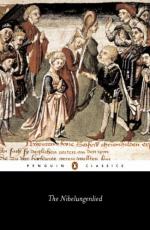|
This section contains 6,534 words (approx. 22 pages at 300 words per page) |

|
SOURCE: “Conclusion: The Alternative to Heroism” in The “Nibelungenlied”: History and Interpretation, University of Illinois Press, 1992, pp. 101-14.
In the following excerpt, Haymes explores the conflicts between the heroic, the courtly, and the diplomatic in the Nibelungenlied and contends that the tale serves as a warning against the abuse of new values.
The Nibelungenlied presents us with two fatally flawed heroes, Siegfried and Hagen, representing two sharply contrasted literary and ethical patterns. The first half of the poem demonstrates the problems that arise when social order becomes blurred and the false ideals of chivalric courtliness are followed. Siegfried is led astray by the power of minne and he eventually dies because of his error. He pretends to a social status that is not his in order to gain his goal. He follows the pattern of the ideal knight of the new generation, the king who performs service in...
|
This section contains 6,534 words (approx. 22 pages at 300 words per page) |

|


